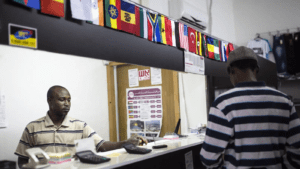Remittances is an exciting part of the financial services ecosystem, especially in Africa. It is dynamic, chock-full of innovation and has a very clear impact on the lives of customers.
Remittances in Africa arguably came to the fore in the 90s, when Dr. Kofi Amoah and other visionaries convinced Western Union and MoneyGram to enter the African market. Fast forward 30 years later, the war stories and the hard number tell a great story. Remittances into Africa remains strong at about US$56billion per annum, with growth despite COVID-19.
It can however be argued that the revenue model for remittances has plateaued. The traditional over-the-counter model for person-to-person transfer has been disrupted massively by direct-to-account and direct-to-mobile integrations. This has led to a shrinking of margins, with the entry of several micro-players in the industry. Its no wonder that SENDWAVE and WORLD REMIT, which ab initio had direct-to-mobile models.
Remittances for trade
This paper argues that there is a path to regeneration on remittances in Africa. The proposal here is very simple. It argues that the success of the person-to-person retail over -the-counter remittance model be applied to support trade transaction, especially for Micro and small enterprises.
It is a well-known fact that payments in Africa, especially for intra-African trade is slow, opaque and expensive. From personal experience and anecdote, one has head the horror stories of citizens trying to transfer money from Ghana to Nigeria to pay for e-commerce items, school fees and others.
I heard the fascinating tale in Guangzhou of how traders in Accra, mobilized funds, sent it via a designated person to Lome so they could undertake outbound Western Union, Ria or MoneyGram transactions to China to pay for ordered goods. This will be cashed out in China and the payments made. The point is that there is a use-case and potential for adapting remittance rails for trade, and this should be encouraged.
Indeed, companies like MoneyGram have bill payment services in their other operations off the continent, and it thus stands to reason that this could easily be carried over.
The SaaS Model and White Labels
A low-cost, high-impact model to achieve this can be found in the current innovation where the major remittance companies are offering their rails on an SaaS basis. This means players in Africa could innovate and package their own proposition that could then ride on these rails.
Thus, rather than undertake the complete Research & Development (R&D) for a bespoke cross-border payment service, financial service players could enter partnerships with the key remittance companies and develop their own white labels that can the be marketed aggressively. This will significantly reduce the go-to-market run -way and deliver exponential impact as regards AfCFTA and other regional trade aspriations. It is estimated that such a move, could immediately unlock a US$70billion windfall, in intra-African trade.
Enter the BoG Sandbox and PAPSS
It must be said that this ideation must be subject to real -world boundaries, especially as regards risk mitigation and compliance. The role of the Central Bank is critical here, to guide innovation. That is why the establishment of the Bank of Ghana (BoG) directorate and the initiative on sandboxes to foster innovation is exciting.
The time is now for fintechs, banks and policy makers to step in with courage to push forward on this next step of remittances, in a mnners similar to what was done in the 1990s, where against all odd, remittance services were introduced in Africa. Another key factor that bodes well in this regard is the Afreximbank initiative, the Pan African Payment and Settlement System (PAPSS).
As noted by Governor Ernest Addison of the Bank of Ghana in a recent presentation at the Ghana Academy of Arts and Sciences: “It is expected to facilitate remittances, offer securities settlement and provide opportunity for Point of Sales and Automated Teller Machine transactions. Direct participants of the PAPSS are the national central banks and regulated financial institutions, as well as payment service providers.
At present, PAPSS has undertaken successful integration from test and development environment to production environment for all the six (6) countries of the WAMZ, namely Gambia, Ghana, Guinea, Liberia, Nigeria and Sierra Leone. Ghana, Nigeria and Gambia have successfully carried out controlled live transactions.”
From all indications, PAPSS, if it continues its trajectory of development, will be the game -changer in this new phase of facilitating in & cross-border remittances and payments.
In conclusion, one must borrow again from Governor Addisons presentation: “Cross border payment systems are not easy to implement. First cross border governance arrangements differ. Secondly laws across different jurisdictions may differ and multiple AML CFT regimes including KYC requirements can become a challenge.” But therein lies the opportunity for real impact and profit. It will be exciting to see how the next chapter of remittances will pan out in Africa.
>>>the writer is currently service as Head of Marketing, Corporate Communications and Customer Experience at Universal Merchant Bank (UMB), Ghana’s oldest merchant bank. His career has included stints as marketing lead for MoneyGram, in Anglophone Africa (+Angola, Mauritius and Mozambique). He is passionate about financial inclusion in Africa.











